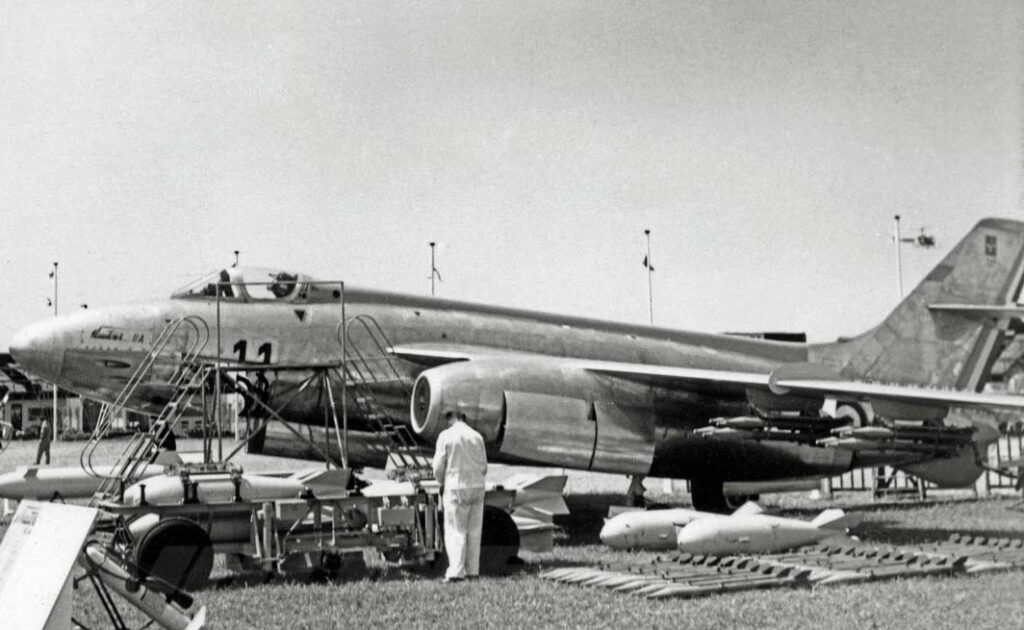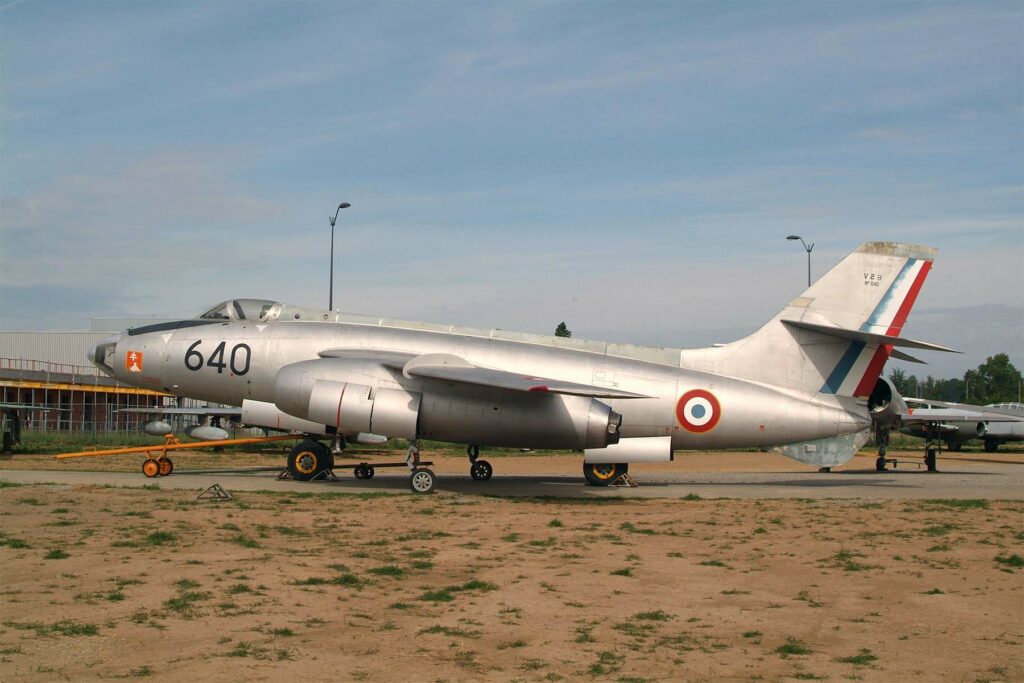The Sud-Ouest SO 4050 Vautour is a French twin-engine, multirole jet aircraft designed for bombing, interception, and reconnaissance.
In brief
The Sud-Ouest SO 4050 Vautour was a versatile, twin-engine jet aircraft developed by France in the early 1950s. It featured a distinctive shoulder-wing design and was powered by two Atar turbojet engines, allowing speeds up to 1,056 km/h (656 mph). The Vautour could operate in various roles, including as a bomber (Vautour IIB), interceptor (Vautour IIN), and reconnaissance aircraft (Vautour IIA), demonstrating France’s post-war aviation capabilities. Its armament included cannons, a variety of bombs, and air-to-air missiles for the interceptor version. Despite its innovative design and multirole capability, the Vautour saw limited service with the French Air Force and was primarily exported to Israel, where it saw combat.

History of the Development of the Sud-Ouest SO 4050 Vautour
In the aftermath of World War II, France sought to rebuild its aviation industry and develop a jet aircraft capable of performing multiple roles, including strategic bombing, aerial interception, and reconnaissance. This ambition led to the development of the Sud-Ouest SO 4050 Vautour by the French manufacturer SNCASO (Société Nationale de Constructions Aéronautiques du Sud-Ouest). The Vautour was designed to meet the French Air Force’s diverse operational requirements in the emerging Cold War context, where speed, versatility, and performance at high altitudes were paramount.
The development program was initiated in the late 1940s, with the Vautour taking its maiden flight on October 16, 1952. The aircraft was a response to the French military’s need for a jet-powered platform that could ensure the nation’s security and project power beyond its borders. Its development reflected France’s ambition to establish itself as a leading aerospace nation and maintain strategic independence during the Cold War.
Design of the Sud-Ouest SO 4050 Vautour
The Sud-Ouest SO 4050 Vautour featured a unique design that set it apart from its contemporaries. Its airframe was built around two SNECMA Atar turbojet engines, which were positioned in pods under the high-mounted swept wings, providing the Vautour with powerful thrust and high-speed capability. The aircraft had a length of 15.73 meters (51 ft 7 in), a wingspan of 15.12 meters (49 ft 7 in), and a maximum takeoff weight of approximately 20,000 kilograms (44,092 lb).
The Vautour’s design allowed for a crew of two or three, depending on the variant, with a pressurized cockpit and an ejection seat for each crew member. The bomber and reconnaissance versions featured a glazed nose for the navigator/bombardier, while the interceptor variant was equipped with a radar nose. The aircraft’s armament configuration varied by role, including cannons, bombs, and missiles.
One of the Vautour’s main advantages was its multirole capability, which allowed it to perform a wide range of missions with a single airframe design. However, this versatility came with drawbacks, such as compromises in specialized performance areas compared to dedicated platforms. Despite these challenges, the Vautour introduced important innovations in French military aviation, including the use of in-flight refueling to extend its operational range.
Performance of the Sud-Ouest SO 4050 Vautour
The Vautour’s performance was marked by its high speed and versatility. Powered by two SNECMA Atar turbojets, the aircraft could reach a maximum speed of 1,056 km/h (656 mph) and had a service ceiling of 13,000 meters (42,650 ft). Its range was extended through the use of external fuel tanks and in-flight refueling, making it capable of conducting long-range missions.
Compared to its contemporaries, such as the English Electric Canberra and the American Douglas A-3 Skywarrior, the Vautour offered a good balance of speed, payload, and operational flexibility. Its ability to fulfill multiple roles with a single airframe was both an advantage and a limitation, as it could not always match the performance of specialized aircraft in specific tasks.
Variants of the Sud-Ouest SO 4050 Vautour
The Vautour was produced in three main variants to fulfill different roles:
- Vautour IIA: Reconnaissance variant equipped with cameras and electronic sensors.
- Vautour IIB: Bomber variant capable of carrying a range of conventional and nuclear weapons.
- Vautour IIN: All-weather interceptor equipped with radar and armed with cannons and air-to-air missiles.
Each variant was tailored to its specific mission profile, with differences in avionics, armament, and equipment reflecting the intended operational role.

Military Use and Combat of the Sud-Ouest SO 4050 Vautour
The Sud-Ouest SO 4050 Vautour saw limited use with the French Air Force but was notably employed by the Israeli Air Force, where it participated in combat operations during the Six-Day War and the War of Attrition. In Israeli service, the Vautour conducted bombing raids, reconnaissance missions, and air intercepts, demonstrating its versatility and effectiveness in a combat environment. Its performance in these conflicts highlighted the Vautour’s capabilities as a multirole aircraft, despite facing newer and more advanced enemy aircraft and air defenses.
The Vautour was eventually phased out of service as newer aircraft with improved performance and capabilities became available. In France, it was replaced by platforms such as the Dassault Mirage series, while Israel transitioned to American-made aircraft like the F-4 Phantom II and the A-4 Skyhawk for its future operational needs.
The Sud-Ouest SO 4050 Vautour was a significant aircraft in the history of French military aviation, representing an ambitious attempt to develop a multirole jet capable of meeting the diverse requirements of modern air warfare. Despite its limited adoption and operational challenges, the Vautour showcased France’s post-war aerospace innovation and contributed to the evolution of jet aircraft design and capabilities. Its service with the Israeli Air Force further underscored the aircraft’s combat potential and the strategic value of versatile, multirole platforms in conflict scenarios.
Back to the Fighter Jet section.